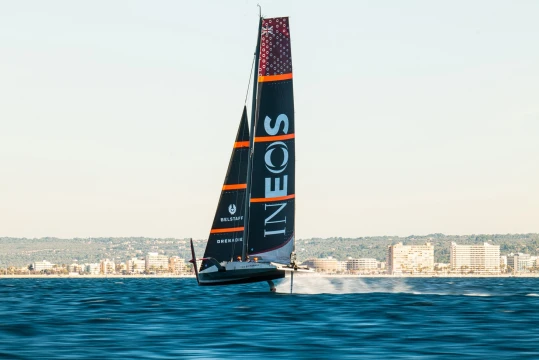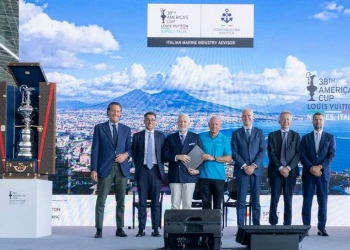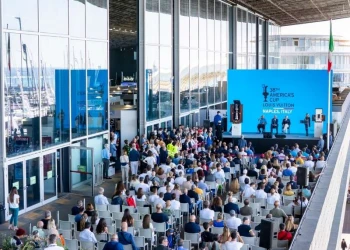
Ugo Fonollá / America's Cup
Ineos T6, data gathering and technique training
Ben Cornish and Giles Scott had the pedal to the floor once again out at the Ineos Britannia winter training base in Palma for another highly productive day of both data gathering and technique training.
The early part of the session saw the team practicing and refining take-off transitions and protocols, popping T6, the ‘Silver Bullet’ as the team calls her, with ease before splashing down and repeating. Once flying, the sailors went on long blasts up towards Maguluf and back to Arenal at breath-taking speeds into the 40-knot ‘sound barrier’ and throwing in some more than decent foil-to-foil tacks and gybes. At one point, T6 sailed through a fleet of International Dragons, the three-man keelboats that were last sailed in the Munich Olympics in 1972 and a neat juxtaposition was cast between the old and the new, showcasing just how far the sport of sailing has come in 50 years.
Furthermore, the onsite recon team photographer caught some very interesting shots dockside into the cockpit of T6 with the computer screens turned on, revealing a huge mass of data that the team are capturing and presenting to the sailors. Alongside the usual wind and speed data, the telemetry also captures rudder inversion and rudder rake plus some very precise mainsheet, jib and main traveller load and angle data. All of this is live-linked back to the data and design teams both in Palma and Brackley, Northamptonshire home of Mercedes AMG-F1 Applied Science, for full analysis and you suspect that, just like in Formula 1, the team can dive into the data and offer the sailors detailed feedback. Sailing is very much a science at this level.

Jeff Causey, the Palma shore crew manager, offered an insight into the sessions afterwards saying: “The goals are always just to keep learning moving forward. We always set out at the beginning of the day with an agenda and a lot of times we measure a good day by ticking off the things we intended to tick off, but we're learning a lot about the boat that that we didn't expect as well which is a good thing, so time on the water is where those gains come. That's really the priority for us.”
And the team have put huge, valuable miles on the clock this week which has propelled the programme forward. Now with the boat going into the shed for upgrades as the weather closes in until Thursday, the confidence that Ben Cornish, Giles Scott, Leigh MacMillan and Bleddyn Mon have injected into the programme through their outstanding performances on the water, takes T6 onto the development trajectory that it was designed for. Interestingly on Saturday, the recon unit reported that the team used the old MN1-1P mainsail that was declared back on the 19th December 2022 despite the new mainsail, the MN2-1P that was declared on the 12th January 2023, being seen loaded into the chase boat. The team used the J3-1 that was declared on the 10th January 2023 as the breeze came up in the afternoon having used the J1-1 (declared 19th December 2022) for the morning pop-up testing.
Chris Schirmer, the team’s boat captain was seen hopping onboard to check the port foil and as Jeff Causey reported: “We're still transitioning from a commissioning phase of signing the boat off structurally and mechanically and crossing into learning and becoming more performance driven as well, so Chris gets on the boat a lot to check on things we have questions about, what the geometry is and making sure everything is working all right and checking on strange noises and that sort of thing.” Schirmer seemed to be paying particular attention to the join between hull and foil and at one point was seen shimmying out on the foil to get a closer look at the wings and the connection between the lower arm and the foil cant arm before staying onboard with a video recorder focussed on the foil and arm.

The session concluded after a spectacular nose-dive after the ride height got out of kilter whilst flying on the starboard foil and it’s interesting to watch the knock-on effects of how small tweaks or mis-judgements quickly escalate into more dramatic consequences. Foiling monohulls at this level, just like Formula 1 cars, are only for the elite.
We wait to see what developments come out of the Ineos Britannia shed on Thursday but another big tick at eye-watering pace was recorded today for the team.
On-Water Recon Unit Notes: Ineos Britannia helmsman Ben Cornish commented after the British team’s ultra-successful last sailing session two days previously that “this is why we came to Palma – for days like these”. He will likely be saying the same about the team’s twelfth sailing day today which saw the wind blowing at from 240 degrees at a peak of 14 knots, creating near perfect conditions for the four-person crew of Cornish and fellow helmsman Giles Scott along with trimmers/flight controllers Bleddyn Mon and Leigh McMillan to put the silver T6 LEQ12 through its paces around the length and breadth of Palma Bay.
The early part of the day was spent practicing take offs with the team sailing just a few hundred metres airborne before dropping back to a slow displacement mode ready to accelerate into another immediate take-off. After 45 minutes of this the team set off on a series of prolonged windward leeward runs around the bay from close to Magaluf in the west all the way down to near Arenal on the east side of the bay.
Multiple non-stop laps of this course were sailed with numerous foiling gybes and tacks, both of which looked more assured than during the previous session (possibly due to the flatter sea state today). Estimated top speeds upwind were close to 30 knots and downwind close to 40 knots.
At one point a fifth man joined the sailors – Chris Shirmer the T6 boat captain – and he was spotted filming the port foil arm joint in action while the boat was sailing upwind on starboard.
The boat looked largely under control throughout the day and appeared stable in flight at speed. However two big, nose-first downwind splashdowns around 1530 were followed by a prolonged wait with a technician aboard down below before the sails came down at 1555 and the long tow-in began.
No damage to the boat was reported. A strong wind forecast for the coming days means Ineos Britannia will not sail again until Thursday earliest.






